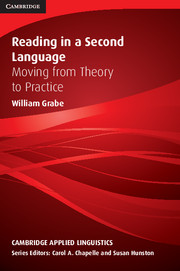Book contents
- Frontmatter
- Contents
- Series editors' preface
- Preface
- I FOUNDATIONS OF READING
- II PATTERNS OF VARIATION IN READING
- III DEVELOPING READING COMPREHENSION ABILITIES
- Chapter 10 Building main-idea comprehension
- Chapter 11 Becoming a strategic reader
- Chapter 12 Building awareness of discourse structure
- Chapter 13 Vocabulary and reading comprehension
- IV EXPANDING READING COMPREHENSION SKILLS
- References
- Author Index
- Subject Index
Chapter 11 - Becoming a strategic reader
from III - DEVELOPING READING COMPREHENSION ABILITIES
Published online by Cambridge University Press: 05 August 2012
- Frontmatter
- Contents
- Series editors' preface
- Preface
- I FOUNDATIONS OF READING
- II PATTERNS OF VARIATION IN READING
- III DEVELOPING READING COMPREHENSION ABILITIES
- Chapter 10 Building main-idea comprehension
- Chapter 11 Becoming a strategic reader
- Chapter 12 Building awareness of discourse structure
- Chapter 13 Vocabulary and reading comprehension
- IV EXPANDING READING COMPREHENSION SKILLS
- References
- Author Index
- Subject Index
Summary
One of the greatest accomplishments of reading research in the past quarter century is the portrait of the metacognitively sophisticated reader.
(Pressley, 2002a: 305)In Chapter 10, reading strategies were introduced as a major means for building effective main-idea comprehension through instruction. A number of individual strategies were introduced because of their effectiveness in supporting comprehension. It was also noted that these strategies are better taught as part of the process of teaching comprehension through interactions around texts, rather than creating separate sets of activities for teaching and practicing each discrete strategy. This chapter focuses on the development of the strategic reader, rather than strategies themselves. The strategic reader is one who automatically and routinely applies combinations of effective and appropriate strategies depending on reader goals, reading tasks, and strategic processing abilities. The strategic reader is also aware of his or her comprehension effectiveness in relation to reading goals and applies sets of strategies appropriately to enhance comprehension of difficult texts.
Before exploring the advances made toward developing strategic readers, it is necessary to address three major issues surrounding strategy instruction in reading: (a) the relationship between skills and strategies; (b) the relationship between metacognition and strategies; and (c) the role of metalinguistic awareness in comprehension.
Skills and strategies
During the 1970s, when it first dotted the reading landscape, the term strategies signified a form of mental processing that deviated from traditional skills-based reading. However, any distinctions between skills and strategies that seemed apparent then have begun to fade, leaving many to wonder where skills end and strategies begin…. The same procedures (e.g., finding the main idea) can fit under both the skill and strategy categories.
- Type
- Chapter
- Information
- Reading in a Second LanguageMoving from Theory to Practice, pp. 220 - 242Publisher: Cambridge University PressPrint publication year: 2008



